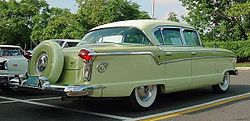
A continental tire or a continental kit is used in the United States for an upright externally-mounted spare tire behind an automobile's trunk.
These were available as factory-installed or aftermarket "kits" with full-sized spare wheels. The term is also applied to a cosmetic accessory to the car's rear, giving the impression of a spare tire mount.
The term also describes a non-functional bulge stamped into the trunk lid. The simulated continental tire bulge design was featured on the 1956 Continental Mark II and through successive generations until the 1998 model year.
Early spare tire mounts
[edit]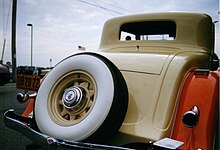
Early automobiles' pre-mounted spare tire and wheel combination typically meant an external mounting because motorists often needed to change tires.[1] Automakers often mounted a spare tire, or two, on the rear of the car.
Some cars featured side-mounted spare tires in the fenders behind the front wheels.[2] Automakers also offered side-mounted spare tires as an option.[3] Early European sports cars had their spare tire attached to the back of the automobile since their trunk or storage space was often minimal. However, these rear- or side-mounted spare tires were not considered continental tires.[4]
The development of the enclosed trunk on automobiles meant the spare tire could be placed out of sight. This arrangement used up valuable space for carrying luggage. Manufacturers offered the sidemount option to increase trunk capacity.[5] Some sports cars accommodated the spare tires inside the trunk resulting in a tight fit. In the case of the Austin-Healey 100, it even projected a portion of the tire into the passenger area, necessitating a vinyl cover in the passenger cabin.[6]
The continental tire mount
[edit]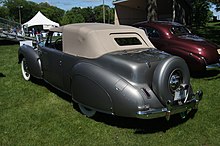
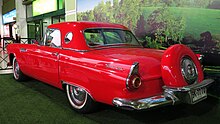
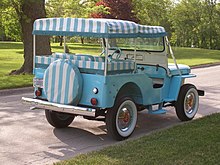

Edsel Ford had a unique car custom-built after returning from a trip to Europe in 1938.[7] He wanted a "continental look," and a spare tire mounted on the trunk.[7] Using the Lincoln Zephyr chassis that was chopped and channeled, stylist Eugene T. "Bob" Gregorie, designed a convertible with a long hood and a spare tire mounted to the rear to reinforce the image of a low speedy automobile.[8] The 1939 Lincoln Continental's short trunk with its external rear spare tire mount became a distinctive design. Reaction was so positive that Lincoln produced the car in 1940 through 1942 and returned after World War II, between 1946 and 1948.[9]
While this was not the first car to either carry its spare above the rear bumper or integrate it into the rear bodywork, it was the first to do it so elegantly, and thus this feature became known as a "continental tire" even if the design was found on other brands.[4]
Similar external spare tire placements were added as standard or optional to popular mass-market and also described as a "continental kit", borrowing their name from the production Lincoln Continental.[10] The aftermarket accessory rear mounted spare became popular in the early 1950s using the "continental" description. These kits included extensions for the rear bumper with a valance between the repositioned bumper and body, thus forming a platform or shelf to mount the spare wheel and tire.[9] Consumers were also able to have "continental kits" installed on almost any vehicle.
There is a legend that Henry Ford II complained that the trunk of his personal Ford Thunderbird did not have room for a set of golf clubs without removing the spare tire.[11] The 1956 model year Thunderbird included a spare tire mounted outside as standard equipment.[12] However, adding the weight of the tire and mounting behind the rear wheels affected the car's ride and handling adversely.[13] For the 1957 model year, the Thunderbird's trunk was stretched 5 inches (127 mm) to allow the spare tire back inside, although the continental mounting was still optional.[14] This external spare wheel mount became a customizing aftermarket appearance accessory during the 1950s.[15]
In the United States, external continental tire mounting was a factory option for various types of cars during the 1950s and early 1960s. On some smaller models – such as on the Nash Metropolitan and Jeepster Commando – the continental tire was a standard feature. The two-passenger Nash Metropolitan's rear-mounted spare tire was more convenient because the trunk was accessible by folding down the seatback on the early (1954 through 1958) models.[16] The large-sized 1957 Mercury Turnpike Cruiser was the top-of-the-line model and included what Ford described a "Dream Car Spare Tire Carrier" among its many standard features.[17]
The car's rear bumper was often extended, and the tire had a fabric or metal cover. The bracket for the spare wheel was designed to swing away for access to the trunk. Manufacturers included continental tire mounts for their perceived "distinctiveness" and to increase luggage space in the trunk, such as on all the 1954 Nash Custom models.[18][19]
The Jeep DJ was available in a "Surrey Gala" appearance package from 1959 until 1964.[20] Included were a fringed top, seats, and a continental tire mount with a colorful vinyl-coated fabric covers in "candy stripes" of pink, green, or blue to match the car's body colors.[21]
Simulated continental tire
[edit]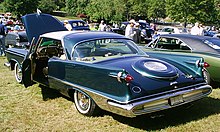
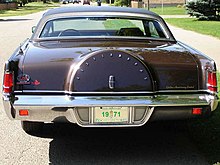
Automotive historians also use this term to describe a nonfunctional circular bulge stamped into the trunk lid to give the impression of a spare tire.[9] However, some argue that the spare hump is not "continental" anymore.[22]
Several 1950s Italian-bodied Chrysler concept cars popularized this design feature.[9] The trunk lid bulge was later embraced by Chrysler designer Virgil Exner and incorporated on many cars. The luxury 1957 Imperial was available with a simulated spare tire cover for the trunk lid.[23] Subsequently, the design element was featured on mass-market models such as the 1959 Plymouth Belvedere and included on the compact Plymouth Valiant by 1960.[9][24][25] Some critics described this bulging styling element on the trunk lid as a "toilet seat."[26]
The Lincoln Continental Mark III in 1969 included a "bump" in its rear deck lid to vaguely substitute the original 1939 Lincoln Continental spare tire design.[4] Lincoln described this feature as its "traditional 'simulated' spare tire carrier".[27] This distinctive rear design continued on the Mark series, including the Mark VIII coupe produced through 1998. [28]
Other cars that incorporated versions of a simulated spare tire bulge include a squared stylized suggestion of a Continental kit on the 1964 Imperials.[29] The 1982 through 1987 Lincoln "Bustleback" four-door sedan design prominently featured the Continental model name as part of the circular trunk lid bump.[30]
Modern use
[edit]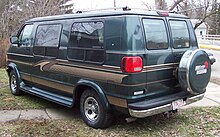

Contemporary examples of continental kits are sometimes found on old and newer customized automobiles, including late-model Lincoln Continental cars that never included a factory design or option.[31][32] It has become an accessory that typifies "the spirit" of the 1950s.[33] After-market continental kits are available for customization of 200 different automobile models.[4] Some after-market applications may not enhance the car's design.[34]
Continental kits and trunk lid add-on spare tire trim were also made popular by the garish pimpmobile era of the 1970s and featured in "Super Fly" movies.[35][36] Continental kits and simulated spare tires were also featured in some of the transformations done on the Pimp My Ride show.
Continental tires are known as 'fifth wheels' in hip hop slang. For example, in the Houston hip-hop culture, "slabs" feature a rear-mounted wheel "cut in half and enclosed in a fiberglass casing."[37] There are custom continental kits for lowrider bicycles available.[38]
Numerous compact sport utility vehicle (SUV) models include an external rear-mounted spare tire from the factory. Accessory spare tire mounts that fit into a car's tow hitch are also available.[39] Recreational vehicles may also have a spare tire on the rear. The wheel and tire combination may be exposed or covered with soft or hard materials and may feature logos or other designs. These rear spare tire mounts are no longer described as "continental tires". Moreover, manufacturers have improved the packaging to mount spare tires under the car or cargo area floor.[40] The externally rear-mounted tire appears on Jeep Wrangler and Mercedes-Benz G-Class vehicles to facilitate easy access when off-road.[40]
See also
[edit]References
[edit]- ^ Commerce, United States Congress Senate (1965). Tire Safety, Hearings before the Committee on Commerce United States Senate 89th Congress First Session 89-1, on S.1643, May 25, June 7, August 13, 1965. p. 125. Retrieved 15 July 2022 – via Google Books.
Instead of carrying two or three spare tires, as the early drivers did, today's motorist may drive through the entire life of a set of tires without ever using the spare tire...
- ^ Boggart, Angelo Van (2010). Just 30s. Penguin. ISBN 9781440241222. Retrieved 15 July 2022 – via Google Books.
The body of this 1932 Nash was built by the Seaman Body Corp. It has dual sidemount spare tires and five louvers on each side of the hood.
- ^ Earnest, Brian (2010). Just Chevys: True Tales & Iconic Cars From America's No. 1 Automaker. Penguin. ISBN 9781440241208. Retrieved 29 May 2024 – via Google Books.
This four-door sedan wears dual sidemount spare tires. The option was a rare one and is seldom seen on 1936 Chevrolets.
- ^ a b c d Donnelly, Jim (November 2006). "A Classy Rear". Hemmings Motor News. Retrieved 29 May 2024.
- ^ "'Candid' Clark gets pictures for an ad in "Life" ... and a No. 1 car to boot! (advertisement for Terraplane". Life. Vol. 2, no. 20. 17 May 1937. pp. 54–55. Retrieved 15 July 2022 – via Google Books.
18 cubic feet in the standard enclosed rear compartment which was originated in cars built by Hudson. In either trunk or compartment models, entire space is usable for luggage when spare tire is carried in a smart side-mount, available at a special low price
- ^ Anderson, Gary G. (2000). Austin-Healey 100, 100-6, 3000 Restoration Guide. MotorBooks International. pp. 54 and 59. ISBN 9781610608145. Retrieved 29 May 2024 – via Google Books.
- ^ a b Schuon, Marshall (14 October 1990). "About cars: A 50th Birthday For Edsel Ford's Continental". The New York Times. Retrieved 29 October 2020.
- ^ "The Origins of the Lincoln Continental – The story of the creation of a design classic". Ford Motor Corporate. 2024. Retrieved 29 May 2024.
- ^ a b c d e Feibusch, Rick; Hacker, Geoff (4 February 2012). "The Continental Kit – "That Tire On The Back"". undiscoveredclassics.com. Retrieved 29 May 2024.
- ^ Auto Editors of Consumer Guide (27 May 2007). "1941 Lincoln Continental". Archived from the original on 2 November 2016. Retrieved 15 July 2022.
- ^ Rothermel, Bill. "History of the Ford Thunderbird 1955-2005" (PDF). artistryinmotion.org. Archived from the original (PDF) on 25 July 2008. Retrieved 29 October 2020.
- ^ Mueller, Mike (2003). Thunderbird Milestones. MotorBooks International. pp. 24–25. ISBN 9781610592208. Retrieved 29 May 2024 – via Google Books.
- ^ Flory, Jr., J. "Kelly" (2008). American Cars, 1946-1959, Every Model, Year by Year. McFarland. p. 729. ISBN 9780786452309. Retrieved 29 May 2024 – via Google Books.
- ^ Vance, Bill. "1955-57 Ford Thunderbird". Canadian Driver. Retrieved 29 May 2024.
- ^ "The Continental History". lincolnanonymous.com. Archived from the original on 28 September 2007. Retrieved 29 October 2020.
- ^ Auto editors of Consumer Guide (23 October 2007). "1954-1962 Metropolitan". auto.howstuffworks.com. Retrieved 10 August 2022.
- ^ "1957 Mercury Turnpike Cruiser 2 Door Convertible". barrett-jackson.com. 2015. Retrieved 15 July 2022.
- ^ "1954 Nash Airflyte brochure". oldcarbrochures.com. Retrieved 29 October 2020.
- ^ Gilbertson, Scotty (9 June 2018). "All Original! 1954 Nash Ambassador LeMans". Barn Finds. Retrieved 15 July 2022.
- ^ Silvestro, Brian (29 December 2016). "This 1960 Willys Jeep Gala Runabout Is Your Ticket to Paradise". Road & Track. Retrieved 15 July 2022.
- ^ Earnest, Brian (1 May 2013). "Car of the Week: 1963 Jeep Surrey Gala". Old Cars Weekly. Retrieved 15 July 2022.
- ^ Niedermeyer, Paul (3 April 2013). "CC Outtake: Because It's Not A Proper Continental Without It". curbsideclassic.com. Retrieved 29 May 2024.
- ^ "1957 New Car Parade". Popular Mechanics. Vol. 106, no. 5. November 1956. pp. 105–106. Retrieved 29 May 2024 – via Google Books.
- ^ Golfen, Bob (23 June 2015). "1962 Plymouth Valiant Signet 200". ClassicCars.com Journal. Retrieved 10 August 2022.
- ^ "1959 Plymouth Belvedere". Mecum Auctions. July 2020. Retrieved 10 August 2022.
- ^ Niedermeyer, Paul (14 May 2020). "Cohort Outtake: 1960 DeSoto Imitating a Chrysler 300F – No Fake Spare Tire Bulges For Me". Curbside Classic. Retrieved 10 August 2022.
- ^ Kilpatrick, Bill (March 1968). "The Lincoln Continental Mark III". Popular Mechanics. Vol. 129, no. 3. pp. 20, 22. Retrieved 29 May 2024 – via Google Books.
- ^ Severson, Aaron (12 September 2009). "Mark of Success: The Lincoln Continental Mark Series > Ate Up With Motor". Ate Up With Motor. Retrieved 15 July 2022.
- ^ DeMauro, Thomas A. (22 September 2018). "Imperial Independence - 1964 to 1970 Chrysler Imperials". Hemmings. Retrieved 29 May 2024.
- ^ "1982-87 Lincoln Continental: The Bustle". oldmotors.net. 11 February 2022. Retrieved 29 May 2024.
- ^ "Continental Kit". kustomrama.com. 28 April 2022. Retrieved 15 July 2022.
- ^ Niedermeyer, Paul (3 April 2013). "CC Outtake: Because It's Not A Proper Continental Without It". Curbside Classic. Retrieved 15 July 2022.
- ^ "A lifelong labour of love for Kelowna's continental kit king, The Vancouver Sun, 28 August 2015". continentalkit.com. Retrieved 29 October 2020.
- ^ Niedermeyer, Paul (6 March 2020). "Cohort Pic(k) of the Day: How To Take The Flair Out Of A Flairbird". Curbside Classic. Retrieved 10 August 2022.
- ^ Golfen, Bob (14 October 2020). "Pick of the Day: 1970 Cadillac Del Caballero fit for 'Super Fly'". The ClassicCars.com Journal. Retrieved 10 August 2022.
- ^ Taylor, Thom (24 March 2021). "Dunham Corvorado: The Most Outlandish Cars Ever Made". MotorBiscuit. Retrieved 10 August 2022.
- ^ Gessner, Daniel (3 May 2019). "'Slabs' and 'swangas' — a look at the cars that were built on Houston hip-hop". Insider. Retrieved 15 July 2022.
- ^ Smith, Steven Cole (12 March 2024). "Attention, Lowriders: Continental Kits Are Available For Your '49–54 Chevy". Hagerty. Retrieved 29 May 2024.
- ^ Lamb, Robert (27 October 2008). "How Spare Tire Mounts Work". auto.howstuffworks.com. Retrieved 15 July 2022.
- ^ a b Demuro, Doug (28 September 2018). "The Rear-Mounted Spare Tire is Dying". autotrader.com. Retrieved 15 July 2022.
External links
[edit] Media related to Continental kit at Wikimedia Commons
Media related to Continental kit at Wikimedia Commons
Part of a series of articles on cars | |||||||||||||
| Body |
| ||||||||||||
Exterior equipment |
| ||||||||||||